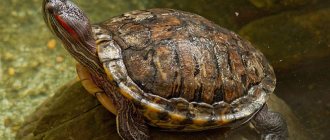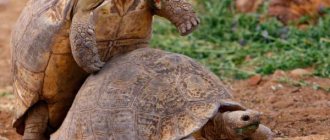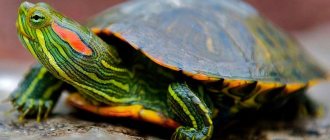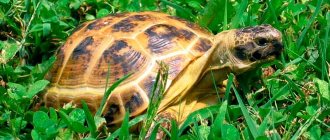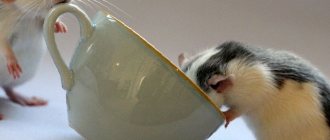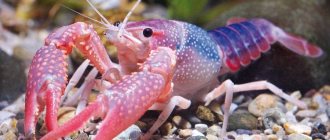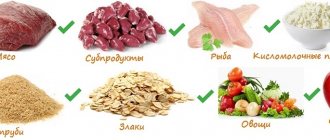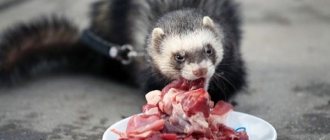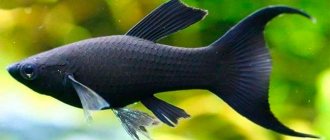Types of land turtles
living on land are divided into about 300 different species , but not all can adapt to home conditions. The following types of land turtles adapt well and are distinguished by their unpretentiousness:
- Egyptian;
- radiant;
- panthers;
- Mediterranean (Caucasian or Greek);
- Central Asian steppe;
- red-footed;
- yellowlegs;
- Balkan;
- yellowheads.
Each species on this list has a high ability to adapt to different living conditions and requires the same maintenance.
Diet for an adult turtle
Red-eared turtles are omnivorous reptiles, but in the wild these creatures prefer to consume protein foods of animal origin: shellfish, crayfish, fish and fry. Despite their predatory nature, exotic pets also need plant food, since this type of food contains useful substances and microelements that help strengthen their shell and health.
Therefore, having got a pet at home, you should find out as much information as possible about what to feed the red-eared turtle, and, importantly, how to feed it correctly
It should be noted that the diet differs for turtles of different ages: small reptiles have individual recommendations regarding food. If you plan to purchase an adult specimen, or your pet has already grown up, then information on what to feed red-eared turtles at home will be useful. List of recommended products:
- Fresh fish is the first thing that should be present in a reptile's diet. When discussing the preferences of red-eared turtles and what to feed your pets, you should remember that they are predators by nature, so reptiles must be fed with fresh fish - sea or river. Many owners give any species because they do not know what fish to feed the red-eared turtle, but this is wrong. Only lean fish will benefit: pike, pollock, blue whiting, halibut, perch and other species, which are given whole. Before serving, the carcass is kept in hot water for a couple of minutes to destroy harmful substances.
- Lean meat – you can feed red-eared turtles with this product once or twice a week. Meat is a source of vitamins and improves the health of the pet, helping the turtle grow and develop.
- Shellfish, crustaceans, and insects are a healthy source of vitamins and nutrients. It is recommended to introduce it into the diet once every 5–7 days.
- Greens are the product that should be fed to a turtle without fail. Pets can be fed dandelion, hyacinth, lettuce, hornwort and other types of flora. Plant foods should make up 50% of the diet.
- Vegetables and fruits, such as pumpkin, tangerines, cucumbers, apples and grapes, will serve as a good treat for your pets.
- Dry food - experienced owners recommend giving dry food only if nothing else is available, as store-bought granules can cause digestive problems.
A balanced diet will promote the growth of your pet and also help avoid the occurrence of various diseases. Any food intended for the turtle should be fresh and at room temperature. Adult pets, whose age is one and a half years or more, are fed twice a week, giving the amount of food that the turtle can eat in half an hour. With this feeding regime, pieces of plant food are regularly placed in the aquaterrarium so that the pet can refresh itself.
Features of keeping a land turtle
At home, the turtle can be kept in a terrarium , aquarium or plastic box. The main condition when choosing a house for a pet is durability, otherwise the turtle may escape.
One animal requires a terrarium measuring 60x130 cm. In a cramped space, the pet will either obsessively start digging in the corners or become lethargic.
Since land turtles love to dig , it is recommended to cover the bottom of the pet’s home with a layer of earth with coconut shavings. Sand is not suitable in this case, since turtles eat it, thereby clogging their stomachs. For your pet to dig, the soil layer must be deep.
Turtles love to hide in shelter , so the terrarium should be equipped with some suitable box, half a pot, etc. The shelter should be of such size that the pet can turn around in it.
The air temperature in the terrarium should be 25C–27C. In addition, it is necessary to equip a separate place heated by a lamp, where the temperature will be within 30C–33C.
living in sunny countries at home need an additional source of UV lighting . To do this, you can buy a special lamp for reptiles at a pet store. Without UV rays in the pet’s body, vitamin D3 will not be produced, which means calcium metabolism, which is needed for shell growth, will deteriorate.
Ideal diet for turtles
When developing the right diet for turtles, the key factors are:
- fiber content;
- protein level;
- balance of calcium and phosphorus;
- fruit content (for some types);
- content of animal proteins (for omnivorous species);
- content of mineral elements;
- water content.
You should not rely on general feeding recommendations without taking into account the specific species the diet is intended for. It is very important that the diet meets the needs of the particular turtle that lives with you. There is no single “correct” diet for a turtle that is suitable and safe for all species. This statement is also true when it comes to dry food sold in pet stores. Generally speaking, ready-made food leaves much to be desired and cannot serve as a substitute for a diet based on the natural feeding behavior of a turtle of a particular species.
What to feed your turtle?
In the wild, turtles get their own food. They feed on various algae, grass, roots and berries . At home, the owner’s task is to provide the pet with a diet that includes vitamins and minerals that are beneficial for growth and development.
Land turtles eat mainly plant foods. But it is not recommended to feed your pets the same foods. The diet should be varied.
You can feed your turtle:
- Greens: clover, wheat germ, dandelions, coltsfoot, parsley, lettuce, tradescantia, aloe.
- Vegetables: carrots, cabbage, peas, pumpkin, zucchini, cucumbers, tomatoes, beets.
- Berries: cherries, currants, raspberries, grapes, strawberries.
- Fruits: apricots, bananas, plums, oranges, apples, tangerines, pears.
To make it easier for the turtle to eat, the fruits are cut into small pieces .
Soft bananas and berries can be given whole. Be sure to remove the seeds from the fruit, otherwise the turtle may choke. Your pet's diet should include protein foods . These could be slugs, worms or boiled meat. Do not feed pet cockroaches or crickets to your turtle. You can buy red worms for them at the pet store.
Calcium plays an active role in maintaining the shell in good condition. Therefore, cottage cheese, semolina or buckwheat porridge should be introduced into the diet of a domestic turtle every week.
Approximate daily diet for a land turtle:
- any fresh sprouted greens (parsley, oats, etc.) – 50 g;
- fresh beets – 30 g;
- cabbage leaves – 30 g;
- fresh carrots – 20 g;
- boiled potatoes – 30 g;
- minced meat – 5 g;
- white bread – 20 g;
- vitamin supplement (fish oil or other) – 1 g.
It is recommended to give your pet additional food once a week. It includes the following products:
- dry seaweed;
- bran;
- raw sunflower seeds;
- dry yeast;
- soybean meal;
- dry balanced food for land turtles;
- non-poisonous mushrooms (champignons, boletus and others).
Turtles need water. To do this, you need to place a bowl of water in the terrarium . Sometimes turtles knock over the bowl and spill the water; in this case, in order not to dilute the humidity, the bowl can be removed and the pet can be offered a little something to drink every day.
Some pet turtles drink during baths, which should be given to them every week. For other pets, drinking water once a month is enough.
Products prohibited for turtles
Improper nutrition can lead to irreversible changes in your pet’s liver and shorten its life. Therefore, food products for feeding a land turtle at home must be selected carefully.
Turtles should not be fed:
- spicy herbs;
- spinach;
- garlic;
- onions;
- raw potatoes;
- citrus peel;
- cherries;
- domestic cockroaches;
- crickets;
- grasshoppers;
- eggshells, as they can cause salmonellosis;
- indoor plants with poisonous leaves (elody, oleander, ambulia, azalea, euphorbia, dieffenbachia);
- milk;
- food for other pets;
- any prepared foods;
- the drug gamavit and vitamin D2, which are toxic;
- canned food;
- human food: sausage, cheese, cereals, fried and boiled dishes.
It is not recommended to feed your pet the same type of fruit or vegetable. Food should be varied.
What to feed your pet turtle in winter?
In winter, turtles are less active than in summer, so they may eat less. The amount of food for your pet may decrease, but the diet should be just as varied.
Since not all products are available in winter, and some fresh vegetables, fruits and herbs are very expensive, you can feed your pet beets, carrots, cabbage, boiled eggs , and raw meat.
Three groups of turtles
Based on the type of nutrition, turtles are divided into three groups: carnivores, omnivores and herbivores
. Each of them corresponds to a certain ratio of animal and plant foods. Feeding inappropriate food for each group of turtles is fraught with diseases of the internal organs, digestive complications, and metabolic problems. You also need to include calcium and vitamins in your diet weekly. What food should be given to each group?
Predatory
The food of predatory turtles should consist of 80% animal food and 20% plant food. This group includes almost all aquatic species and all young aquatic ones, such as young red-eared, caiman, trionics, swamp, musky, etc.
The main food for them is:
- lean fish, live or thawed, with entrails and small bones. For young turtles, the fish should be finely chopped (spine, excluding ribs) with bones, for adults - whole or large pieces. Large bones can be ground or finely chopped.
- beef or chicken liver is given once a week;
- seafood such as green (not pink) shrimp, sea cocktail;
- mammals (small): naked mice, rat pups, runners.
The turtle can eat all seafood, as well as fish, only raw; heat-treated food should not be given;
Additional food
, which should be given once a week, serves:
- Dry food for freshwater turtles, for example, in the form of sticks, tablets, flakes, granules, capsules, Sulfur, etc.
- Insects: moth, food cockroaches, grasshoppers, bloodworms, crickets, earthworms, gammarus and so on;
- Mollusks, amphibians, invertebrates: slugs, frogs, small snails with shells, tadpoles and similar swamps.
It is prohibited to give to predatory turtles:
meat (beef, chicken, pork, lamb, sausages, sausage, any type of minced meat, etc.), as well as fatty fish, milk, cheese, bread, fruit, dog or cat food, etc.
The diet of this group of turtles should consist of 50 percent animal food
and 50 – vegetable. Omnivorous turtles include semi-aquatic and adult aquatic turtles, some types of land turtles: spiny turtles, coora turtles, adult red-eared turtles, Spengler's turtles, red-footed turtles (coal turtles), etc.
Their menu consists of half animal food, see the list above, and half plant food, the list is below. Aquatic turtles are pampered with fish
and seafood (as animal food), and mice are given to land animals.
- Plant food for aquatic species are plants growing in water conditions,
- Land animals are given plants that live on the ground, and fruits and vegetables are added to them.
Herbivores
The menu of this group of turtles is based on plant foods, which make up 95% of the total diet, animal food consists of 5%.
Herbivores include: all land turtles, including radiated, flat, Central Asian, Greek, spider and others.
The main food of this group is:
- greens, it makes up 80% of the entire menu (semi-dry or fresh salads, edible leaves, flowers, succulents, herbs.
- vegetables - 15% of the diet (pumpkin, cucumbers, zucchini, carrots...)
- fruits that are not very sweet (apples, pears, etc.) are represented in 5% of the menu.
Additional food
once a week, it includes:
- non-poisonous mushrooms, such as russula, boletus, champignons, etc.
- dry balanced food for land turtles of the brands “Sera”, “Tetra”, “Zumed”.
- other: soybean meal, dry yeast, raw young sunflower seeds, bran, dried seaweed...
It is prohibited to give meat; this category includes: any minced meat, sausages, sausage, chicken, beef, pork, etc.). Also fish, milk, cheese, cat or dog food, bread...
How to properly feed a land turtle?
It is necessary to feed your pet at home at the same time . It is best to do this in the morning. He will get used to this schedule and will wait for food himself. In addition, when feeding a pet turtle, it is recommended to follow some rules:
- Young turtles are fed daily. At the age of two years, pets begin to be fed once every two days.
- Food should be poured only into clean containers.
- Portions should be small. But since turtles eat exactly as much as they need, there is no need to be afraid that your pet will overeat.
- As soon as the turtle eats, the remaining pieces of food should be removed immediately.
- Strong odors and loud noises during feeding can negatively affect your pet's digestion.
- It is not recommended to teach your turtle to eat food from your hands. She will quickly get used to this and will refuse to eat from the bowl.
Feeding turtles too often leads to obesity and improper formation of the pet's shell, too infrequently - to exhaustion and death.
Adhering to the basic rules and recommendations, it is quite simple to organize the feeding of a land turtle at home.
The main thing is to feed your pet only approved foods and not give prohibited ones. A well-fed pet that has received tasty and vitamin-rich food will always be happy and active.
Nutritional features of turtles
Depending on the type of food, there are three main subgroups of pet turtles:
- Carnivorous species in most cases feed on meat, but approximately 10% of the diet must necessarily consist of a variety of plant products. These species include many aquatic turtles, as well as young red-eared and swamp turtles;
- Herbivorous species need to feed on plant and vegetable crops, as well as fruits, but occasionally eat small amounts of lean meat products. Such exotics include land Central Asian and Mediterranean species;
- Omnivorous species eat equal amounts of meat products and major plant crops. This group is represented by red-eared, marsh and red-footed turtles.
It is necessary to feed pet turtles correctly, since the metabolism is noticeably disrupted if the diet is incorrectly formulated. The quality of life of the exotic deteriorates, and various diseases associated with the digestive system arise.
Herbivorous turtles
The main daily diet of a herbivorous turtle includes lettuce and cabbage, as well as dandelion leaves and forbs, the amount of which should be about 80% of the total diet.
Also, the main products may include vegetable crops, represented by zucchini, cucumbers, carrots and tomatoes, the amount of which can reach 15% of the daily menu. The remaining 5-6% should be bananas, pears and apples, and berry crops.
The following products supplement the basic diet of herbivorous turtles:
- champignons and other easily digestible types of edible mushrooms;
- plant crops in the form of sorrel, plantain, coltsfoot, lawn grass, thistle leaves, above-ground parts of clover, peas and timothy, sprouted oats and speedwell;
- fruits and berries in the form of orange, tangerine, mango, plum, apricot, peach and melon;
- vegetables in the form of bell peppers, beets, onions, carrot tops, squash and pumpkin, artichoke and horseradish, as well as main legumes;
- berries in the form of watermelon, strawberries and wild strawberries, raspberries and blackberries.
You also need to supplement your daily diet with bran, raw sunflower seeds, dry yeast and dry seaweed.
Once a week, it is imperative to give your domestic exotic a hard-boiled egg, and once every four weeks - garden snails and slugs, or fairly large insects.
Predatory turtles
The main daily diet of a predatory turtle includes low-fat varieties of river and sea fish, including pollock, hake, cod, navaga and perch meat, as well as fresh beef or chicken liver.
Such products are given to domestic exotics approximately once a week. Adult pets eat pieces of fish with the addition of finely crushed backbone. Young individuals need to cut food into fairly small pieces.
Supplements to the main diet of a predatory turtle include the following products:
- raw seafood, including shelled shrimp, squid, octopus tentacles, mussels and oysters;
- crab meat, frogs, food hairless mice or laboratory rats;
- land snails, large pond snails, apple snails and coil snails;
- some insects, including beetles, feeder cockroaches, earthworms, mealworms, hairless caterpillars, bloodworms, tubifex and woodlice.
Plant components in the form of aquatic plants, fruits and vegetables, and some types of cabbage are also necessary for domestic turtles to fully develop.
You should absolutely not feed your pet predatory turtle the following foods:
- beef fatty meat;
- pork meat;
- lamb meat;
- sausage;
- pates;
- cheeses of any kind;
- dairy and fermented milk products;
- bakery products.
This is interesting! A very good result is obtained by using special industrial diets for feeding, which can be loose, granular, in the form of tablets or capsules, as well as flakes or fortified sticks.
Omnivorous turtles
The main daily diet of an omnivorous turtle includes plant foods and animal products, given in equal amounts. Land omnivorous turtles need to be fed animal food in the form of food mice, baby rats and frogs, insects, snails and slugs, and aquatic ones - fish menu and seafood.
Plant foods for terrestrial exotics include terrestrial plants, vegetable crops, some fruits and vegetables, while aquatic species prefer algae and any other non-poisonous aquatic plants.
